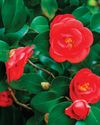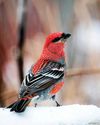يحاول ذهب - حر
Grow A Desert Oasis
August/September 2019
|Birds & Blooms
Easy ways to combat drought, extreme temperatures and rock-filled soil.

WHEN YOU PICTURE THE AMERICAN SOUTHWEST, you may see dusty, windswept deserts that stretch for miles, with a lone cactus and occasional tumbleweed to break the monotony. That’s certainly one version.
Gardeners in the Southwest see another image— one that’s filled with the beautiful blooms of hardy native plants, drawing hummingbirds and butterflies. They know it takes hard work to get there, but they also know it’s worth it.

“So many people are eager to learn about sustainable gardening,” says Marisa Thompson, urban horticulture specialist at New Mexico State University (NMSU). “All over the region, people attend classes to understand a little more about water usage, drought stress, soil health, beneficial insect populations (including pollinators), species selection and wildlife habitats.”
Here are the most valuable lessons they learn.
HOT AND COLD
هذه القصة من طبعة August/September 2019 من Birds & Blooms.
اشترك في Magzter GOLD للوصول إلى آلاف القصص المتميزة المنسقة، وأكثر من 9000 مجلة وصحيفة.
هل أنت مشترك بالفعل؟ تسجيل الدخول
المزيد من القصص من Birds & Blooms

Birds & Blooms
Ready to Fly
For birders, spring migration is something to look forward to and be celebrated, but how do birds know when it's time to begin their travels?
2 mins
December 2025 / January 2026

Birds & Blooms
COOL AS A Camellia
When temperatures drop, most plants wait out the chilly months, but camellias put on a show. Discover how to have these beauties thriving in your yard.
2 mins
December 2025 / January 2026

Birds & Blooms
Festive Feathers
Readers braved the winter chill to capture these snowy snapshots of the season's most beautiful birds
2 mins
December 2025 / January 2026

Birds & Blooms
Winter Gems
With raspberry-red feathers, pine grosbeaks cheer up chilly landscapes wherever they land
2 mins
December 2025 / January 2026

Birds & Blooms
the mysterious lives of NIGHTHAWKS
These creatures of contradiction aren't hawks and aren't the most active at night, but they are worth knowing
3 mins
December 2025 / January 2026

Birds & Blooms
Adventure Awaits
Pack your bags, get on board and find your next vacation destination in these captivating photos from far-flung travels
2 mins
December 2025 / January 2026

Birds & Blooms
It's All in the Needles
Get to know the greenery to identify these conifers
1 min
December 2025 / January 2026

Birds & Blooms
Christmas Tree Do's and Don'ts
These pro tips will help you get the most out of this classic holiday fixture
2 mins
December 2025 / January 2026

Birds & Blooms
Trailing Houseplants
Simple, easy-to-grow plants for hanging containers
3 mins
December 2025 / January 2026

Birds & Blooms
Better Off with Bats
Rethink the unsung heroes of the night and why you should support them
2 mins
October / November 2025
Translate
Change font size

